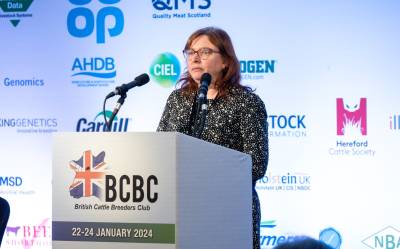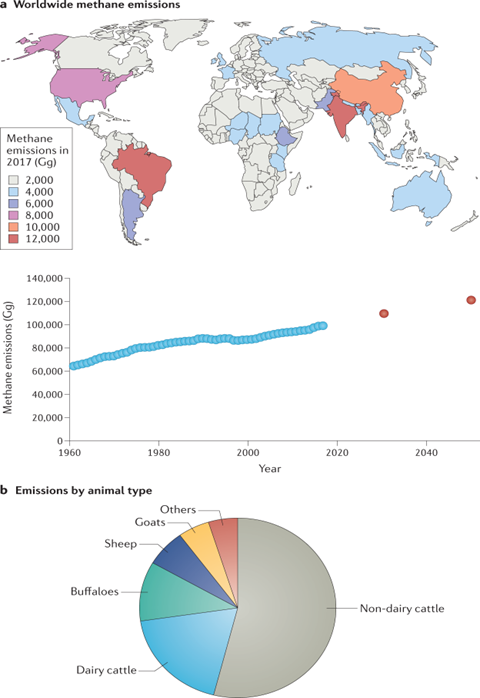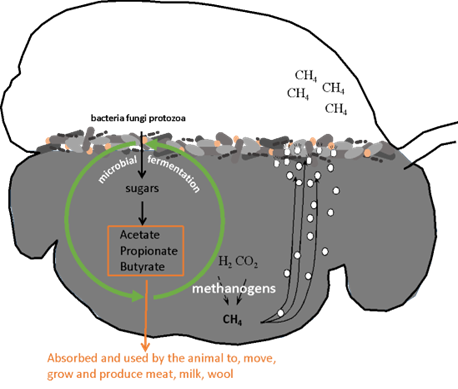
Background
Professor Huws is an expert in Sustainable Livestock Production, with an emphasis on ruminants. Her research is focussed on reducing methane emissions from ruminants and ensuring effective land use to capture carbon efficiently, with the underlying aim of ensuring that ruminants continue to fulfil our food security needs globally in terms of protein and micromineral supply.
A ‘One-Health’ Perspective on Sustainable Ruminant Production
It is estimated that greater than 11.7% of the human population have insufficient access to safe and nutritious food and hence suffer from nutrient deficiencies and conditions, such as anaemia and stunted growth in children. Concomitantly, it is predicted that the world’s population will reach 10.4 billion by the 2080s , placing a further pressure on the demand for safe and nutritious food . Ruminant products are high in protein and micronutrients, thereby providing a highly valuable source of nutrition, however, ruminants are a major source of methane (CH4), a greenhouse gas (GHG) that has between 27 and 30 times the global warming potential (GWP) of carbon dioxide (CO2); although recent studies suggest that it’s lifespan in the environment is approx. 12 years, which is far less than originally thought. Global CH4 emissions from ruminants, most of which come from enteric fermentation, have continuously increased over the past decades (Figure 1), and are currently estimated to contribute 30% of global anthropogenic CH4 emissions, 17% of the global food system GHG emissions and 5% of global GHG emissions (Figure 1). Therefore, irrespective of the environmental lifespan of CH4, there is a real challenge in ensuring the health of the human population, whilst at the same time ensuring the health of our environment in terms of the ruminant sector.
How is CH4 produced?
The productivity and environmental impact of the ruminant are mainly consequences of the biochemical process that occurs as feed enters the rumen and the process of microbial digestion . Essentially, dietary carbohydrates are broken down by the rumen microbes (Figure 2) and go through biochemical processes that result in the production of volatile fatty acids (VFAs), which serve as a source of energy for the animal. This process results in the generation of hydrogen, and this is used by methanogens to mainly convert CO2 into CH4. Therefore, CH4 production is a normal process, and any mitigation strategies must ensure that energy provision for the animal is not detrimentally affected, with the ideal that strategies for CH4 mitigation also enhance productivity, thus enhancing food security and economic profitability. CH4 emissions are reported in different ways, firstly daily emissions (g/day), yield (g/Dry Matter Intake), Intensity (Kg/ based on Kg milk produced for dairy or liveweight gain for sheep and beef. Improving CH4 intensity for the ruminant meat sector effectively means that animals go to slaughter earlier, which is obviously desirable in terms of economic viability and food security e.g Kg meat produced is the same, but those animals produce less CH4 because of their reduced lifespan. Lastly, a new measure has been proposed, particularly in terms of monitoring within breed and across breed differences, which is based on reporting emissions in relation to average measurements within a herd/flock (residual methane yield).

Figure 1. Global Methane Emissions. Note: Methane emission estimates calculated from Food and Agriculture Organization of the United Nations (FAOSTAT) enteric fermentation data, shown by a. region (red dots on graph show predicted emissions) and b. animal type (others mainly include non-ruminant emissions). Source: Mizrahi et al., 2021

Figure 2. Carbohydrate fermentation and methanogenesis in the rumen
Progress on reducing CH4 emissions from ruminants
Reducing CH4 emissions from ruminants has been the topic of research for over 50 years (Beauchemin et al., 2020), nonetheless the emphasis has never been greater than it is today, considering the climate and food crisis.
Management Strategies
Many practical solutions can enhance on-farm profitability, whilst also reducing CH4 intensity. For example, earlier calving and enhancing feed efficiency such that milk or growth is enhanced and total CH4 output to produce the same Kg product is reduced. Management practices aiming at increased feed efficiency include implementation of grazing management strategies, for example feeding less mature forages can increase average daily weight gain or milk production and reduce CH4 emissions up to 13% based on CH4 intensity. A recent report from Moredun institute also showed that reducing parasite load can substantially enhance feed efficiency and productivity in ruminants (Moredun institute, 2022). For example, the presence of gastrointestinal parasites cause a minimum 10% increase in lamb CH4 intensity and liver fluke infection can reduce cattle growth by 4%, resulting in a 2% increase in CH4 intensity . Therefore, grazing and animal health plans are critical to ensure sustainable ruminant production, and these are practical strategies which can be implemented relatively easily and will increase the profitability of a farm.
Breeding Approaches
Efforts to breed low- CH4 emitting ruminants with such an “optimum” rumen microbial community are well underway globally. Early data suggest that breeding efforts could result in reductions up to 30% in CH4 emissions based on residual methane emissions (Smith et al., 2021), although much more data is required and is currently being gathered globally. This strategy is exceptionally desirable as it would entail choosing the correct breeding lines which offers a practically feasible option. However, it should be noted that this strategy will take more time to develop as it requires more progeny to be tested and estimated breeding values to then be confirmed.
Dietary Approaches
Dietary interventions can be broadly grouped into the following categories: plant-based strategies (e.g. feeding plants that are high in secondary compounds, such as tannins), targeted CH4 inhibitors (such as 3-NOP, commercially known as Bovaer â ), oils and oilseeds, and hydrogen sinks (e.g. chemicals or microbes that utilize hydrogen so that there is less available for methanogenesis) (Ardnt et al.,2022; Huws et al., 2023). Feeding legumes, which are tannin-rich, can reduce CH4 emissions, for example white clover can reduce CH4 emissions by 11% based on CH4 yield (E nriquez-Hidalgo et al., 2014). Introducing legumes to the land also has the benefit that they will fix nitrogen, therefore reducing the amount of fertiliser which needs to be applied, as well as enhancing above and below ground biodiversity. CH4 inhibitors, such 3-NOP (Bovaer®), can also achieve CH4 reductions of up to 35% based on CH4 intensity and daily CH4 measurements. However, their effects on production gains remains unclear. More recently developed dietary interventions to reduce CH4 emissions include feeding macroalgae. The red seaweed macroalgae Asparagopsis taxiformis inhibits methanogens and consequently methanogenesis, and so can be considered a CH4 inhibitor. It has been shown to reduce CH4 intensity and daily CH4 emissions by up to 80% in both dairy and beef animals, which is the largest reduction achieved to date. The active ingredient in A. taxiformis is bromoform, which is carcinogenic and therefore this strategy requires more animal and human health studies to be obtained to monitor any potential trade-offs in depth.
What does the future look like?
Increasing the sustainable production of ruminants, whilst ensuring food security and environmental health is achievable using a ‘toolbox’ of strategies. Firstly, increasing early calving, enhancing feed efficiency through effective grazing and animal health management practices provide a practical means of balancing food security whilst maintaining environmental health (approx. 20% reductions CH4 intensity possible). Whilst, applying different technologies is known not to result in an additive effect i.e 1+1 does not often equal 2 and will be higher than 1 but lower than 2, stacking of technologies offers a means of further enhancing sustainable ruminant production. For example, applying breeding and/or dietary strategies alongside ensuring effective management strategies could result in a major step-change for the sector. Applying dietary interventions to dairy animals is easier in comparison to beef and sheep, as they can be fed the additive during milking and of course beef and sheep animals spend most of the year grazing. As such, our efforts are now concentrated on developing novel strategies to introduce dietary interventions in a predominantly grazing system e.g in licks. Ultimately, our research targets are to develop many practical strategies (a toolbox) enabling a balance between food security and environmental health, whilst providing options to the sector based on farm type and economic viability.
References
Arndt C, Hristov AN, Price WJ, McClelland SC, Pelaez AM, Cueva SF, Oh J, Dijkstra J, Bannink A, Bayat AR, Crompton LA, Eugène MA, Enahoro D, Kebreab E, Kreuzer M, McGee M, Martin C, Newbold CJ, Reynolds CK, Schwarm A, Shingfield KJ, Veneman JB, Yáñez-Ruiz DR, Yu Z. Full adoption of the most effective strategies to mitigate methane emissions by ruminants can help meet the 1.5 °C target by 2030 but not 2050. Proceedings of the National Academy of Sciiences USA. 2022 May 17;119(20):e2111294119. doi: 10.1073/pnas.2111294119.
Beauchemin KA, Ungerfeld EM, Eckard RJ, Wang M. Review: Fifty years of research on rumen methanogenesis: lessons learned and future challenges for mitigation. Animal. 2020 Mar;14(S1):s2-s16. doi: 10.1017/S1751731119003100.
Enriquez-Hidalgo D, Gilliland T, Deighton MH, O'Donovan M, Hennessy D. Milk production and enteric methane emissions by dairy cows grazing fertilized perennial ryegrass pasture with or without inclusion of white clover. Journal of Dairy Science. 2014 Mar;97(3):1400-12. doi: 10.3168/jds.2013-7034.
Huws S, Oyama LB, Creevey CJ. 2023. FAO draft study on the sustainable use and conservation of microrganisms of relevance to ruminant digestion. https://www.fao.org/3/cc6629en/cc6629en.pdf
Moredun, 2022. Acting on methane: opportunities for the UK cattle and sheep sectors. https://moredun.org.uk/wp-content/uploads/2022/04/SO-634-Ruminant-Report-Methane-April-2022-web.pdf
Smith PE, Waters SM, Kenny DA, Kirwan SF, Conroy S, Kelly AK. Effect of divergence in residual methane emissions on feed intake and efficiency, growth and carcass performance, and indices of rumen fermentation and methane emissions in finishing beef cattle. Journal of Animal Science. 2021 Nov 1;99(11):skab275. doi: 10.1093/jas/skab275.